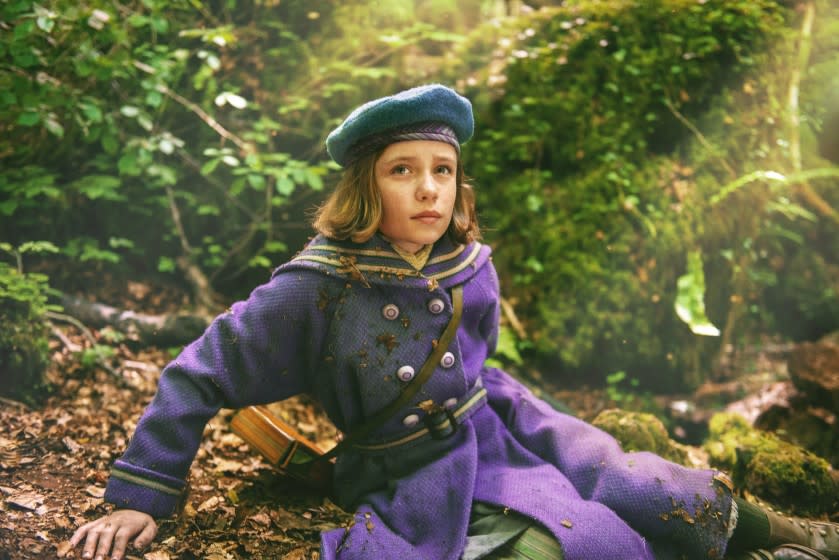'The Secret Garden' ending explained: Why the new adaptation decided to burn it all down

Fans of Frances Hodgson Burnett’s "The Secret Garden" may have noticed some particularly dramatic changes to the ending of the 1911 novel in Marc Munden’s new adaptation. The film, out now on premium video on demand, reimagined the conclusion of the story to better suit its themes and to give its protagonist Mary (Dixie Egerickx) an opportunity to have more agency.
Jack Thorne, who penned the script for the film, which is set in 1947 instead of the early 20th century, wanted to find a way to rid the characters of Misselthwaite Manor, the gloomy house that’s been in disrepair since the end of the war. The solution was to literally burn down the stately home, allowing Mary to run inside and rescue her uncle Archibald Craven (Colin Firth) from the flames — something that does not happen in the novel, which concludes in a much more uneventful way with Archibald simply discovering Mary and his son Colin playing in the secret garden.
“We went through a number of different iterations and a number of different ways of telling it,” Thorne explains. “It was the hardest thing, actually. And I think in the editing it was the hardest thing too. What we decided upon was we needed a way the ending spoke to this great big ruin we’d created in order to tell our version of ‘The Secret Garden.’
"This felt like a way of A) keeping Mary very, very central to the telling and B) getting rid of that specter [of the house] so that the secret garden is the place where they start anew. I think this film is all about casting off history, and Mary casting off her history, and maybe by the end they’ve all been made stronger by casting off the history of Misselthwaite as well.”
Munden adds, “It’s about purging the place. It’s about Mary being able to rescue Mr. Craven in a very real way. It also allows the spirits of the sisters — Mary’s mother and her sister — to help Mary. It unites all sorts of dramatic elements, which are an essential part of the story.”
To film the ending sequence, production designer Grant Montgomery built a massive entry hall and staircase in a soundstage at Pinewood, outside London. The curving staircase evokes the Gothic settings of "Jane Eyre" and "Rebecca," two other stories about mysterious manor houses with tortured men that end in fire.
“We knew we needed to design and build the house because we were going to burn it,” says Montgomery, who used an existing house in Yorkshire as the exterior. “We really couldn’t go to any of these existing stately houses and say ‘Can we set a fire in this house?’ They would just say a flat no. But that allowed us to have an imagination about how Misselthwaite would look and that was exciting.”

While some of the fire was added with CGI, most of the flames were real, with the filmmakers creating a controled burn at Pinewood. It was Egerickx’s favorite scene to film because of the intensity. The actress feels that adding something with a spectacle to the ending will better suit younger viewers, who expect some drama from their movies and TV shows these days.
“It can capture the young audience better,” Egerickx says. “And also I think it’s important to remember that this film is just one film. You still have the 1990s version of the film. You still have the old versions. It’s not replacing them. If you don’t like the ending, that’s completely fine, you can watch the other ones.”
For Firth and Julie Walters, who plays Misselthwaite’s severe housekeeper Mrs. Medlock, the ending helps to remind viewers of what these characters have been through and where they could potentially now go. After the fire, they return to the garden, where there’s a feeling of hope for the future.
“It makes for a dramatic ending,” Firth notes. “But there’s also the feeling that the bitterness and self-obsessed misery of the master of the house has led to its inevitable destruction …. The story begins rooted in misery. But Mary discovers a sense of adventure, and the children, through their own efforts, bring about healing for everyone concerned. The garden is not only an obvious metaphor, but also has its own part to play. Especially in this adaptation, where nature operates like a character in the story.”
“It’s about regeneration,” Walters adds. “They’re going to come out of this. I like it because you get the feeling that it’s a hugely positive growth. Out of devastation and destruction comes this lovely light and growth and life.”


